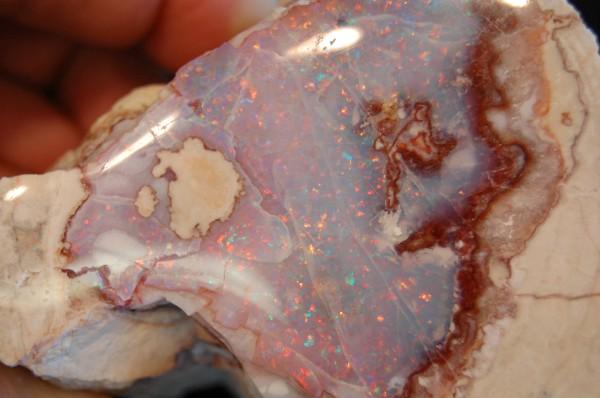In Idaho, Opal is the second largest contributor to the total value of gem material produced. The varieties produced include precious (white and pink), yellow, blue, pink, and common. The Spencer Opal Mine, the largest privately owned gem stone producer in the State, is the major producer of Opal. At Spencer the precious opal occurs as one or more thin layers within common opal partially filling gas cavities within a rhyolite-obsidian flow. About 10% of the material is thick enough to cut into solid gems; the remainder is fashioned into doublets and triplets. The Spencer Mine is the source of pink common opal and pink precious opal. Opal is brittle, heat sensitive, and breaks and scratches easily; additionally, some varieties self- destruct through the loss of water.
Even with these drawbacks, opal's unsurpassed beauty guarantees its status as a premier gemstone. The derivation of its name even adds to its position. Reportedly, opal's name evolved from the Roman word opalus from the Greek word opallios meaning "to see a change of color." The Greek word was a modification of the ancient Indian Sanskrit name for opal, upala, which meant "precious stone." If one spoke in mixed tongues, then opal would be opallios upala, "to see a change of color precious stone." As indicated by the derivation of its name, opal has centuries of history as a treasured gemstone. Historically, beliefs associated with the wearing of opal have varied. The early Greeks thought that opals gave their owners the powers of foresight and prophecy, and the Romans adored it as a token of hope and purity. Eastern people regarded it as sacred, and Arabs believed it fell from heaven.
In the nineteenth century, superstitions grew about the bad luck or fate that could befall one for wearing opal if it were not the wearer's birthstone. Today, these superstitions have diminished, but some people still believe it is bad luck to wear opals. Opal has over one hundred variety and trade names, but the list of accepted or commonly used names is much shorter.
The most important and most widely known opal is the precious opal. Precious opal may be subdivided further by color modifiers, white, black, pinks, and blue, which describe the body color of the opal. Opal is the most colorful of all gems. Its splendid play of color is unsurpassed, and fine examples can be more valuable than diamond. The play of color consists of iridescent color flashes that change with the angle at which the stone is viewed. This phenomenon is often called opalescence. The play of color may consist of large, individual flashes of color (known as schillers), or may be of tiny, dense flashes. The intensity and distribution of the color flashes is a determining factor in the value of an opal. A condition called crazing affects certain opals, causing them to form internal cracks. Crazing is a particularly interesting phenomenon, for it lacks consistency and is unpredictable.
Although it can occur at random, it usually strikes when an opal removed from damp conditions is allowed to dry too quickly, or when an opal is exposed to sudden intense light -- or a combination of these factors. Crazing may also take place when an opal is subject to vibration, as during the cutting and polishing of a specimen. The severity of the crazing and the time it takes to "craze" varies among specimens. The origin of the specimen is often a determining factor to its resistance to crazing. A very gradual drying process over months or even years can in some cases effectively stabilize the stone and allow it to be cut and polished with a substantially reduced risk of crazing. Opals displaying play of color are known as precious opals, and opals lacking play of color are known as common opals. Gems are cut from both the precious and common forms, but precious opal is the primary gem form of this stone. There are many varieties of both precious and common opals.
The most desired and beautiful form of opal is black opal, which is opal with a dark blue, dark green, or black background with a strong play of color. Next in importance is white opal, which is opal with a light colored body color (white, yellow, cream, etc.) with strong play of color. Next in line is Mexican fire opal, a transparent to translucent orange red form of common opal. If Mexican fire opals display play of color, they are known as Precious Fire Opal. Many precious opals, besides being classified as either black or white opals, are further classified based on the distribution and habit of their play of color. There are also many variety names given to the numerous forms of both precious opal and common opal.






